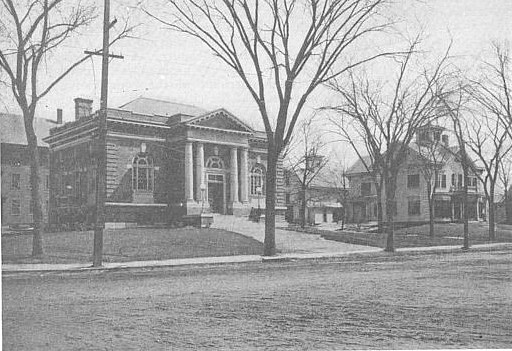
Another Offspring of Old Dorchester
[New England Magazine
- May 1910]By D. ELFLEDA CHANDLER
THAT the importance of a town, in the social or commercial scales of the state to which it belongs, is not always indicated by the number of its inhabitants, is no more fully illustrated than in the case of Stoughton, Mass., a town set apart from Dorchester nearly two centuries since.
Situated just beyond the shadow of Great Blue Hill, and enjoying, with Sharon, the most elevated site between Boston and Taunton, Stoughton, mother of both Sharon and Canton, is a town which Massachusetts may well look upon with pride, whose healthful location is portrayed by the longevity of its citizens, many of whom have nearly reached the century mark.
Good air, good water, and good neighbors, when coupled with excellent schools, liberal churches and numerous social orders, form a combination which makes for comfort to the citizens of any town. Add to these a scenic beauty which is not excelled by any town in Eastern Massachusetts and you have a faint idea of the attractions of Stoughton.
When, in 1726, this budding town decided to free itself from the parent rule, its people chose Stoughton for a title in honor of William Stoughton, then Lieutenant-Governor of Massachusetts.
According to the one requirement made in the incorporating statute, a "learned Orthodox minister, of good conversation," in the person of Rev. Sam'l Dunbar, was settled within the first year of the town's independence. The descendants of this first minister's followers, together with the new comers who have cast their lot in this thrifty little town, today require the services of six able pastors, of as many different creeds, in a like number of beautiful and well supported churches.
Few indeed are the towns in New England where the social, religious, and commercial activities are more in harmony than in Stoughton.
Very little of that class distinction which is proving such a drawback to many country towns, owing to the jealousy aroused, is to found here, on account of the comparative equality of the citizens No very poor and no very wealthy residents are located in Stoughton. Nearly all of the property holders are engaged in the active pursuit of some business or profession, while those employed by them are held in respect and high esteem. Few are yet able to retire from the battle for gold, and it matters little, to the Stoughtonite, what position his brother holds in the ranks, so long as all are engaged in a common cause.
During the year just ended the more energetic and public-spirited faction of business and professional men, headed by Dr. W. O. Faxon, Senator to the Massachusetts Legislature from this district, organized themselves into a Board of Trade, which now numbers 150 members.
This body, though young, has already made its power very apparent in the furtherance of the commercial interests of the town.
No better example of the unity between the public organizations than that shown in the Industrial Exposition, held by the Board of Trade in the Town Hall of Stoughton, in February of the present year, can be cited.
For a town of six or seven thousand inhabitants an Industrial Exposition would seem, to the general public, a most stupendous undertaking, yet Stoughton speaks with pride of the tremendous success of the "Fair," when nearly $2000 was realized clear of all expenses, which amounted to some $600, bringing the donation up to more than forty cents per capita.
Schools, clubs and manufactories, aided by church circles and every public-spirited citizen, joined heart and hand in the cause, until the great Town Hall presented a scene not unlike Boston's Mechanics Building at the time of a Food Fair.

PUBLIC LIBRARY AND CHICATABUT CLUB HOUSE
Stoughton industries only
were represented, yet the entire building was literally crammed with booths and stalls.Upon the first floor the Stoughton Rubber Company exhibited a large line of fine rubber garments, including rain coats, hats, and reefers of all weights, while the process used in their manufacture was illustrated by rubber in the different stages of refinement, from a large cube of the crude material down to the finest sheeting.
The Chelsea Braiding Company exhibited a large line of elastic webbing, braid, and cord used upon surgical instruments, besides fancy weaves used in ladies' belts, gentlemen's suspenders, etc.
The Stoughton Mills gave an interesting display of wool shoddies, and the different stages of development through which the materials pass be-fore being rewoven into cloth for storm skirts, heavy cloaks, men's suiting, and horse blankets.
Upham Brothers, who are all that is left of the many shoe manufacturers who once caused Stoughton to be named as a "shoe town," had turned one corner of the building into a. display-room for a complete and extensive line of high-grade foot-wear. Men's shoes of every size and description, color and last were here shown, while drummers for this line of merchandise hovered about, making mental notes and calculations, for Upham Brothers manufacture shoes for the trade only.
The Belcher Last Company, whom Stoughton claims to be the most extensive manufacturers of lasts in the world, also occupied a large space, in which were shown lasts in all stages of completion, from the rude block down to the finished article.
Chas. Stretton & Son exhibited a large line of ribbed under-garments and knit goods, arranged within a booth which was gaily decked in colored crepe paper, like many of its neighbors.
French and Ward, who manufacture eiderdown and krinkledown, which originated with them, gave a large display of baby blankets, carriage robes, and other woolen goods, including many styles of fancy dress material and suiting.
The Plymouth Rubber Company, a firm which has rapidly come to the front during the past decade, until they claim to be the largest manufacturers of rubberized cloth in the world, displayed samples of the materials which they coat, from the finest silks to the heaviest cloth. Rubber rolls, heels, and other moulded rubber work was shown, together with that used on automobile tops, and wearing apparel worn by the joy riders.
The Packard Dressing Company exhibited a variety of shoe dressings and polishes, which attracted much attention from the fact that many of the articles displayed had been often used by the interested parties without a thought of their place of manufacture. Known only by their title, they were purchased from the retailer without a glance at the name of Stoughton, which appeared under the maker's name.
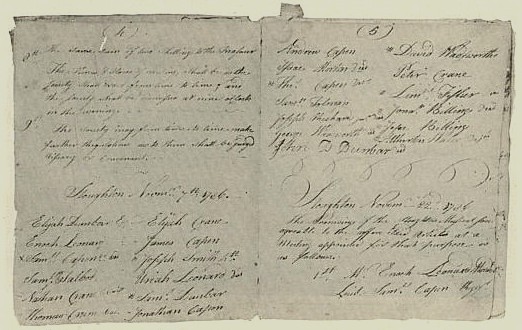
THE FIRST RECORD OF THE OLDEST MUSICAL SOCIETY IN THE UNITED STATES
Another festooned nook, which called forth many exclamations of approval, was the display of portraits and photographs by Mr. Geo. A. Gerard, whose work has become the admiration of his townspeople.
Space forbids that we enumerate the countless exhibitions of smaller pro-portions, such as the box and incubator display of L. P. French Company., the tame bees of Mr. Henry Britton and the illuminating apparatus of the Edison Electric Company.
One other feature of the exposition, which held the attention of the outsider, was the plan for an enormous shoe factory, and a small city, as yet but a plan, existing on paper only, which, in the near future, unless we mistake the ability of the organized Stoughtonites, will be a helpful reality to Norfolk County.
Representative H. E. Holbrook is the promoter of this proposition, by which the townspeople shall build the factory and develop the surrounding country until they can offer homes to seven hundred shoe workers within a short distance of the mill in which they are employed. When all is in readiness they intend to offer free rental, or, perhaps, give the factory outright to a reliable firm who will undertake the manufacture of shoes here.
The site which is responsible for this plan is located very near the South Stoughton station of the N. Y., N. H. & H. Railroad, in a level, open country now occupied only by scattered farms.
During the four days of the exposition a carefully selected program of amusement was furnished and on the evening of the third day Governor Draper, with some members of his staff, lent the dignity of their presence and encouraging words, to the affair.
Stoughton is divided into five sections which can hardly be called villages, but are better described as neighborhoods.
West Stoughton, the location of two factories, has the largest number of homes outside of the centre or town proper.
North Stoughton boasts a square and one church. Smith Stoughton is the home of well-to-do farmers, while the section known as Dry Pond is the birth-place of another business enterprise.
About twenty-five years ago two owners of neighboring farms upon which pop-corn was extensively grown entered into partnership and put upon the market shelled pop-corn in packages. Later they admitted another partner and took the firm name of Smith, Clapp & Gay. Their, business prospered and within a few years they were obliged to buy corn from their neighbors in order to supply customers. The convenience of the shelled corn was at once recognized by the consumer, and today these originators of package pop-corn buy in car-load lots from Western growers, and sell only to the wholesaler. One storehouse in which the corn is kept has a capacity of one hundred tons. Thus it may be seen that even the farmers of Stoughton are more enterprising than some of their neighbors in large towns.
Ponds and rivers abound in Stoughton, which seems to be blessed, beyond the average town, with beautiful walks, drives, and woodland nooks where summer breezes cordially invite one to stray, and watch their antics among the trembling leaves.
Not far from Dry Pond, towards the Centre, Britton's Pond furnishes power for a small factory which has remained in the possession of one family and in continuous operation for more than sixty years.
Three printing presses find support in Stoughton, those used in the publication of two weekly newspapers, the "Sentinel" and "Record," and one entirely devoted to job work, known as the Pequa Press.
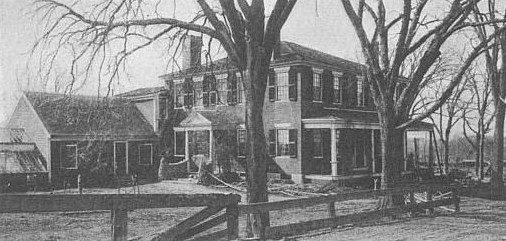
SWAN'S TAVERN, BUILT BY TAUNTON AND BOSTON [TURNPIKE CO.]
Near the source of Salisbury Brook, which flows through Stoughton and Brockton into the Taunton River, stands an old landmark which claims the attention of many visitors to Stoughton. This interesting structure is known as Swan's Tavern, built in
1807 by the Boston and Taunton Stage Company, and presided over by Landlord Capt, Elisha Swan, who caused this halfway house to become most popular as a centre for sleighing and dancing parties, as well as a comfortable resting place for travelers. The coming of the railroad in 1835 robbed the old tavern of its principal support, and today the house, which has been the scene of much revelry in olden times, is but the quiet, peaceful abode of a New England farmer. An autograph upon one of its window panes, dated October 26, 1811, is the only indication of its one-time friends.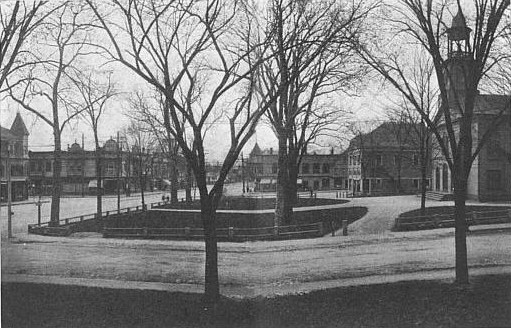
Photo by George Gerard
SQUARE SHOWING SITE OF THE FIRST CHURCH
The square, which constitutes the shopping district of Stoughton, is unusually attractive, while the buildings surrounding the same are much more beautiful than many a large town can boast.
Stoughton Churches
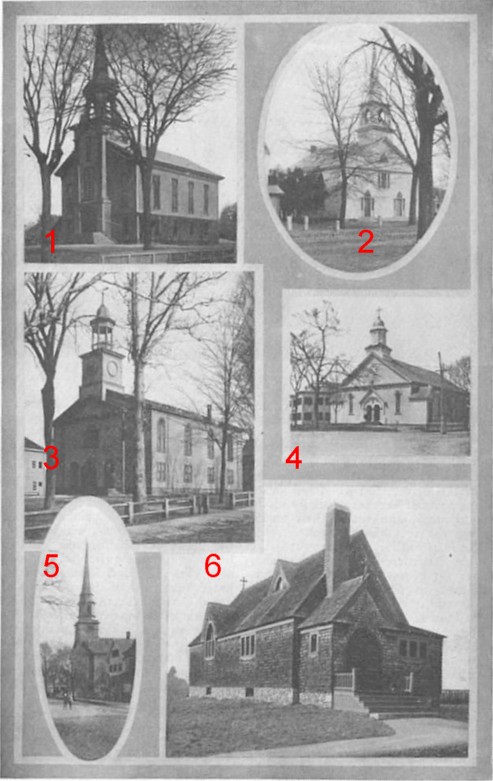
(1) Methodist Church, Pleasant St.; (2) Methodist Episcopal Church, North Stoughton; (3) Universalist Church;
(4) Immaculate Conception Church, Canton St.; (5) First Congregational Church, Washington St.; (6) Trinity Episcopal Church, Freeman St..
About the first structure to claim the attention of the visitor, who enters by trolley, is the handsome Town House, whose massive brick walls, ornamented with fine granite, rise two and one-half stories to a slated roof above which Old Glory constantly waves, while velvet lawns, gemmed with trees and shrubs, relieve the gray outlines of graveled driveways.
Across the square to the left, a church, where Universalists congregate, points its gilded spire, like a guiding finger, upward; while the site of Stoughton's first house of worship is marked by a granite stone on the green that stretches between the church and street.
Beyond this is seen the Public Library, whose exquisite beauty is a triumph of architectural skill, even to the pearl-like lanterns which surmount the marble stairs at the entrance. Dedicated in 1904, the style is strictly modern. A visit to the interior but increases one's admiration, for the fixtures and furnishings fully justify the anticipations aroused by the exterior.
Some over 11,000 volumes are neatly arranged about the shelves while the reading-rooms are filled with magazines and newspapers.
Among the social organizations the oldest and, perhaps, widest known is the old Stoughton Musical Society, which is doubtless the first of its kind to be organized in the United States. This club begun to hold meetings as early as 1762, when it consisted chiefly of the First Parish Church Choir under the leadership of Capt. Samuel Talbot. Not until 1786, however, did it become a recognized organization, when it was made up of the best male singers in all the churches of Stoughton. They met but twice each year, on May Training Day and Christmas, but their fame soon spread abroad until the mother town, Dorchester, be-came jealous of their popularity, challenging them to a contest with her own talent. The meeting was arranged in 1790 and Stoughton, with twenty selected male voices, unaided by instrumental accompaniment, easily won from Dorchester, in spite of the sup-port given the latter by noted Boston singers, female voices and bass viol. Even the defeated musicians were forced to admit the superiority of the winners.
Some time later female voices were admitted to the meeting, which has occurred but once each year since 1825, generally on Christmas day, until recent years, when the date was changed to January first.
The one hundredth anniversary of this society was held in Stoughton Town House, on Nov. 7, 1886, attended by the Governor and the other noted people.
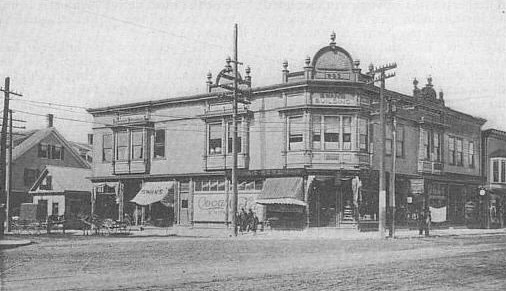
WALTER SWAN BLOCK, STOUGHTON SQUARE
There are now about five hundred members, one hundred of whom, with an orchestra of twelve pieces, accepted the invitation to sing at the Chicago Exposition in 1893, when they were the only New England organization to respond, although several others were bidden and at first intended to appear. All expenses were met by the Society and the success of their work sent their praises far and wide.
The object of the order is to preserve from oblivion the work of our earliest native composers.
Members of the Stoughton Musical Society are now to be found in many other towns around Stoughton. Joseph Belcher, its president, resides in Randolph, as does its present chorister, Nelson Mann. Vice-president R. T. Pratt lives in Holbrook, vice-chorister C. G. Faunce is found in North Abington and trustee Geo. W. Porter in Avon. Trustee K. R. Clifford calls Stoughton home, as does the secretary and treasurer, E. A. Jones, who is one of the most active members, being a most ardent lover of music, which is his profession.
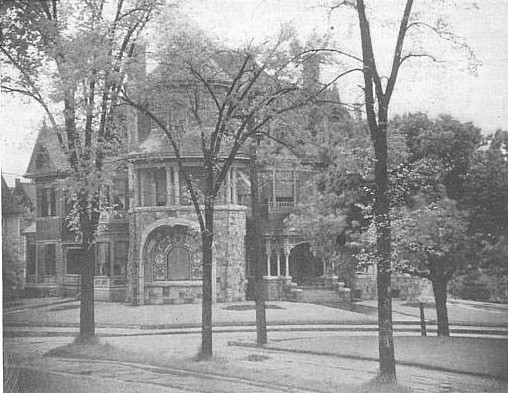
Photo by George Gerard
RESIDENCE OF GEORGE E. BELCHER, SEAVER STREET.
Another society whose influence has done much for the public good of Stoughton, and which has raised the social standard of the town to a high position, morally, is the Chicataubut Club, named for old Chief Chicataubut, the first chief to sign a treaty of peace with the English.
This club, which was at first a gentleman's order, was incorporated under the laws of Massachusetts November 23, 1903, for the purpose of establishment and maintenance of a place for reading-rooms, libraries, and social meetings.
Buying the Atherton Estate, located just beyond the Public Library, they converted the old mansion into a club house, whose appointments and furnishings are all that could be desired. Reception-rooms, reading-rooms, and billiard hall made attractive by velvet rugs, mission furniture, and draperies, offer various means of diversion and entertainment, while the enormous paintings from the brush of a local artist, F. M. Lamb, are a delight to the lover of art.
The club, which began with fifty charter members, is limited to one hundred, and now numbers nearly seventy, with the following officers: President, Mr. Walter Swan; vice-president, Mr. Ira Burnham; secretary, Mr. Edwin Jones; treasurer, Henry S. Jones.
On Jan. 26, 1905, a ladies' auxiliary was formed, beginning with thirteen charter members, which has increased to about sixty, having the following officers: President, Miss Gertrude Belcher; vice-president, Mrs. I. V. Marston; secretary and treasurer, Mrs. N. K. Standish.
During the year of 1909 the stable adjoining the club house was converted into a hall, thirty by forty feet, and equipped with cloak and dressing-rooms of the latest, improved design.
Unlike many clubs of this kind, strict temperance is enforced and gambling in any form is forbidden. Neither religious nor political matters influence the acceptance of a new member, who may come from any church or organization, as long as a good moral record is shown.
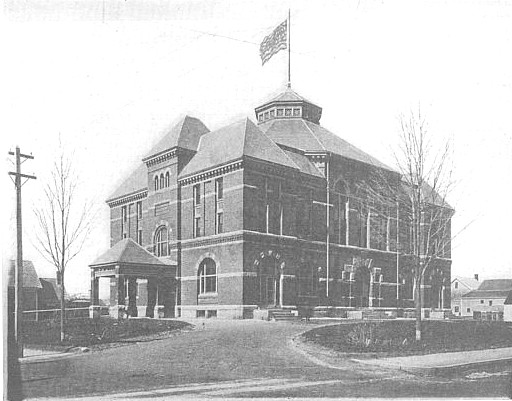
STOUGHTON TOWN HALL
The Stoughton Historical Society has done much for the preservation of valuable records, and the marking of ancient sites.
This society was organized in [1895] under the leadership of Hon. E. C. Monk, who gave the marker which now indicates the southeast corner of the plantation granted to the Ponkapoag Indians, and occupied by them until the last brave passed on, leaving but a memory of a once powerful tribe. The site of the first house, first church and first: school building has been marked by a granite stone given by this society.
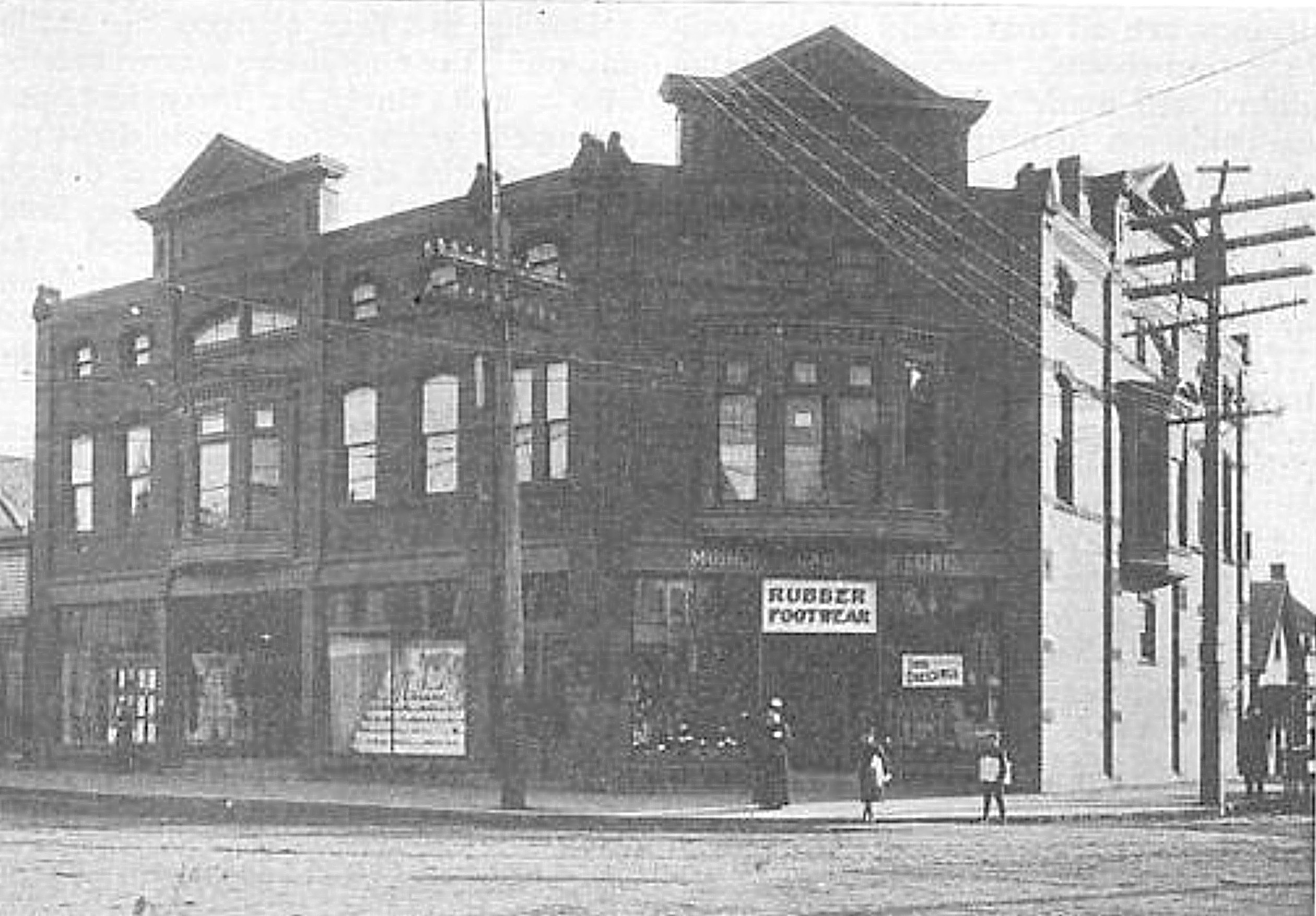
MONK'S BLOCK, STOUGHTON CENTRE
There are now about seventy members, who meet eight times each year at their rooms in the library building, under the leadership of Mr. H. L. Johnson, president, Miss Amelia Clifton, secretary, and Richard B. Ward, treasurer.
The stone given by Mr. Monk also marks the corner of the first land deeded to a white man in Stoughton. Mr. Geo. Monk, to whose ancestor this land was deeded, still owns the property, which consists of a grove of pine and a beautiful body of water, now known as Glen Echo Lake. Here the Apostle [Eliot] preached to the native red men when Stoughton was in its infancy. The sparkling pond, with its natural shore, has never been marred by the hand of civilization. The reservation is now under the management of the Bristol and Norfolk Street Railway Company, who have recently opened the grounds to the public by means of a branch rail-road which runs nearly half a mile through natural forest to the centre of the park. The attractions offered are many and varied. Every accommodation is given picnic parties and tourists, white excellent facilities for boating, bathing, and conoeing, are enjoyed. Bowling alleys, dance hall and an excellent pavilion make of this playground a spot where old or young may find rest or amusement, as suits their mood. Sunday school picnic parties may be found here almost any day throughout: the season, where they delight in the freedom of the grove, as they listen to the song of birds and gather the wild flowers or berries which abound.
Although Stoughton was once known as a shoe town, on account of the many factories where footwear was manufactured, since 1880, these firms have gradually given place to other industries until but one shoe factory remains and four hundred skilled shoe workers go out of Stoughton to their places of employment each morning. The facilities for the manufacture of shoes are as good today in Stoughton as they were thirty years ago, and it is the aim of the people to see the old factories once more in operation and their shoe workers employed again in their home town.
To the manufacturer who would settle here we can say that abundant power, excellent light, and good facilities for shipment without transshipment to Boston, await the new comer while the train service to Boston is excellent and the fare very low when season tickets are employed.
To the farmer we would say that Stoughton land is proving very productive for truck gardening and poultry raising is successfully carried on by many residents, while an excellent Grange is a prominent feature of the social life of this town.
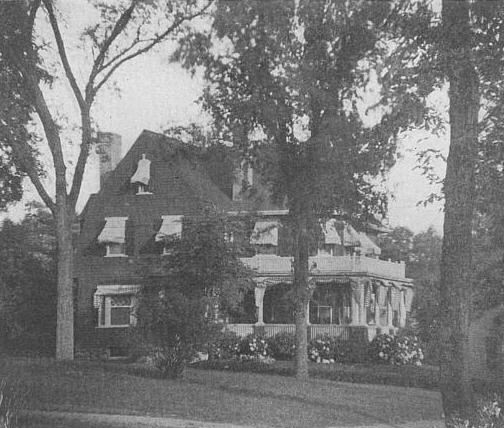
Photo by George Gerard
ANOTHER STOUGHTON RESIDENCE
Schools of every grade, including a High School which prepares the student for college, and a Business School of Shorthand, are maintained at a cost of over $20,000 yearly. And opportunities for social intercourse are unlimited; while markets and shops of every nature, including a large department store, cater to the needs of the household. Add to these a people whose cordial welcome to a stranger is unequaled by any town in Massachusetts and what more can be desired?
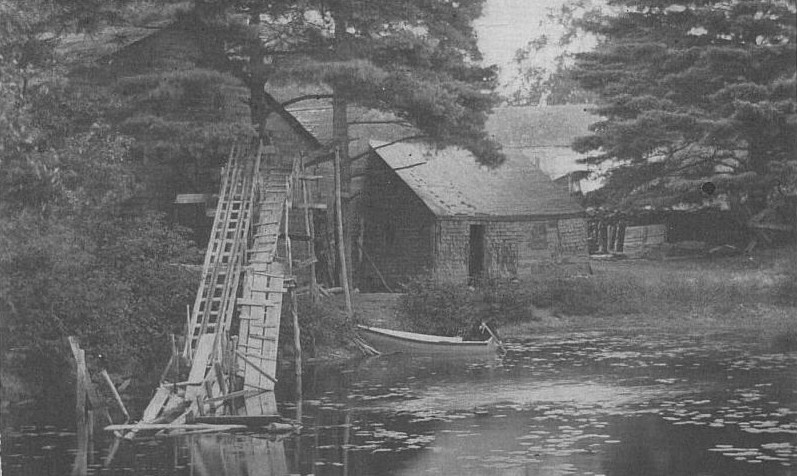
Photo by George Gerard
A BIT OF WEST STOUGHTON, WHERE ARTISTS CONGREGATE